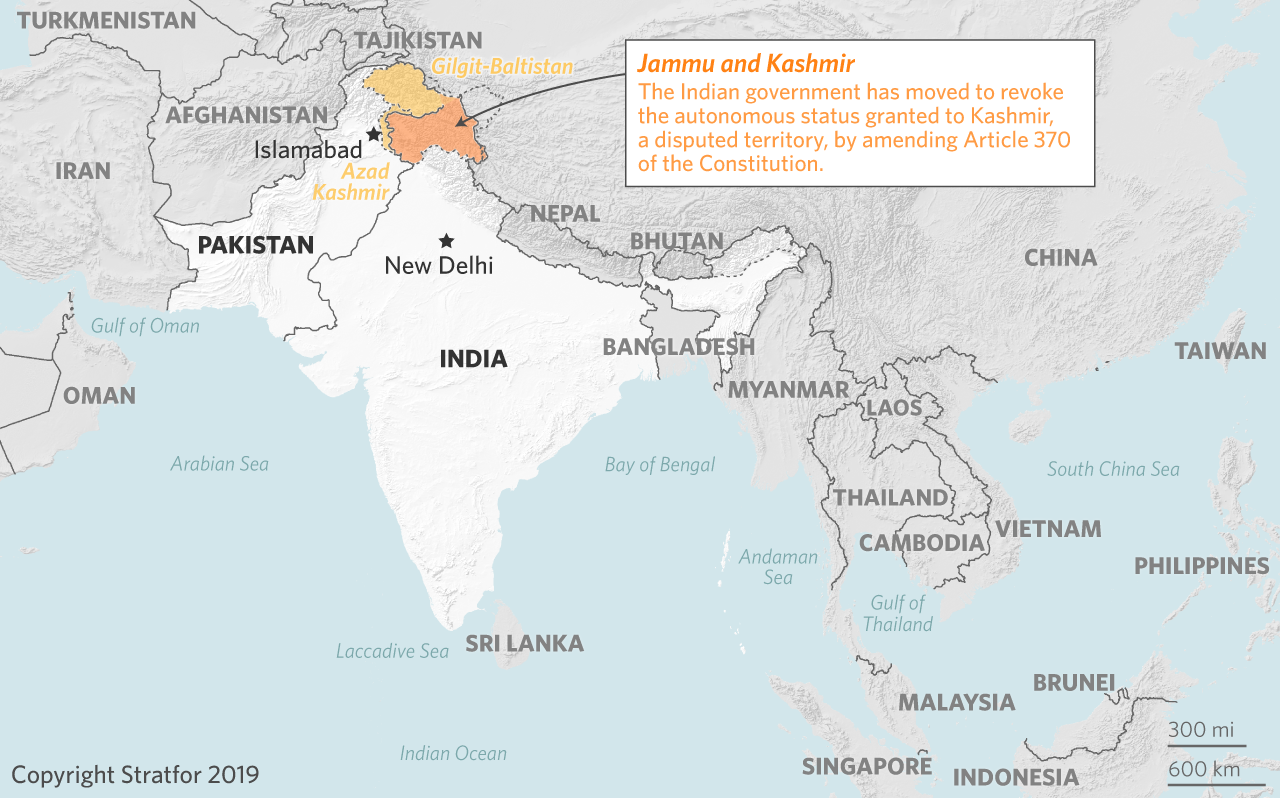This article has been republished with permission from our partner, Stratfor. The original version was first published in Stratfor’s WORLDVIEW and can be found here.
Highlights
- The BJP-led government’s attempt to integrate Kashmir fits into its broader goal of solidifying the political and economic unity of India, whose regions are diverse.
- While the Indian opposition’s strategy will focus on attacking the move as undemocratic, the government will aim to rally nationalist support in the name of national security, continuing a core theme of its reelection campaign.
- The government’s deployment of 38,000 security forces is designed to preempt the expected rise in political violence and potential for a high-profile cross-border attack at a time when U.S. mediation may be unreliable and Pakistan may look to China for support.
- At the same time, the heightened security threat to India could result in opportunistic jihadist attacks in core urban areas.
After promises on the campaign trail, Indian Prime Minister Narendra Modi has come true to his word — energizing his supporters and exasperating his opponents in equal measure. On Aug. 5, Modi began a process to revoke the special autonomous status of the disputed territory of Jammu and Kashmir, igniting a political firestorm in New Delhi and, potentially, tensions with nuclear archrival Pakistan. In line with Modi’s directive, Indian President Ram Nath Kovind issued a presidential decree supplanting the Indian Constitution’s Article 370, which grants Jammu and Kashmir autonomy in managing its internal affairs with the exception of defense, foreign affairs and communications. What’s more, the decree will also impact Article 35A, which restricts non-Kashmiris from buying land in the state, potentially opening the way for non-Kashmiris and Hindus to migrate to the state and alter its Muslim-majority demographics.
The Big Picture
Kashmir lies at the heart of India and Pakistan’s decades-long rivalry. It also involves a domestic dispute in which India’s central government is seeking to assert its authority over a state that harbors an externally backed separatist movement. For Prime Minister Narendra Modi, whose Bharatiya Janata Party won a landslide reelection in May, the decision to revoke Kashmir’s special autonomous status fulfills a longstanding pledge of the party and provides a steppingstone toward greater political and economic unity in India.
See The India-Pakistan Rivalry
At the same time, the Rajya Sabha, India’s upper house of parliament, also passed a bill calling for the division of the area into two union territories, one to be known as Jammu and Kashmir, and the other as Ladakh. That bill — the Jammu and Kashmir Reorganisation Bill — will go for a vote to the lower house of parliament, where Modi’s Hindu-nationalist Bharatiya Janata Party (BJP) holds a majority following a landslide reelection in May. But while the BJP’s supporters lauded the announcement as historic, the opposition, including the Indian National Congress, the Tamil Nadu-based Dravida Munnetra Kazhagam, and the Kashmir-based Jammu and Kashmir Peoples Democratic Party, have all decried the move as an affront to the nation’s democratic principles. The move is yet another component of the BJP-led government’s bid to bolster India’s political and economic unity — particularly as Kashmir represents one of the country’s biggest secession threats. Needless to say, however, Modi’s path is full of pitfalls: By tightening its grip on Kashmir, India risks fanning the flames of the local insurgency, which could ultimately escalate its standoff with its nemesis, Pakistan.
The Center and Periphery: The Domestic Element
The Kashmir dispute contains overlapping domestic and international components. Domestically, it highlights the tension between the central government in New Delhi, which is trying to assert its authority over a peripheral state that harbors a deeply ingrained culture of autonomy that predates independence in 1947. India’s only Muslim-majority state, Kashmir’s special constitutional status under Article 370 has always been a point of contention for the BJP, whose Hindu nationalist base has agitated for the state’s greater integration with the country.
 Over the weekend, Indian authorities placed former Kashmiri chief ministers Mehbooba Mufti and Omar Abdullah under house arrest as part of a massive security crackdown that has included the deployment of 38,000 paramilitary forces, the severing of internet and mobile connections, and a ban on public gatherings. Mainstream Kashmiri politicians have long called for dialogue in the hopes of reducing the number of Indian security personnel stationed in the state (there are currently more than half a million Indian soldiers in Jammu and Kashmir), given that they exercise expanded legal authorities under the Armed Forces (Special Powers) Act and have frequently been accused of human rights abuses. Consequently, an enlarged military presence — especially if it becomes semipermanent — will likely exacerbate these grievances.
Over the weekend, Indian authorities placed former Kashmiri chief ministers Mehbooba Mufti and Omar Abdullah under house arrest as part of a massive security crackdown that has included the deployment of 38,000 paramilitary forces, the severing of internet and mobile connections, and a ban on public gatherings. Mainstream Kashmiri politicians have long called for dialogue in the hopes of reducing the number of Indian security personnel stationed in the state (there are currently more than half a million Indian soldiers in Jammu and Kashmir), given that they exercise expanded legal authorities under the Armed Forces (Special Powers) Act and have frequently been accused of human rights abuses. Consequently, an enlarged military presence — especially if it becomes semipermanent — will likely exacerbate these grievances.
India vs. Pakistan: The International Element
Kashmir also lies at the heart of India and Pakistan’s decades-old rivalry. Each country governs the state in part but claims it in full. Following the independence of both countries from the United Kingdom in 1947, Kashmir’s then-Hindu ruler ultimately joined India in exchange for military protection against a Pakistan-backed domestic uprising aimed at wresting control over the state. What began as a proxy conflict soon morphed into the first of India and Pakistan’s three wars over the territory. Today, Pakistan administers two regions (Azad Kashmir and Gilgit-Baltistan), India three (Jammu, Ladakh and Kashmir) and China two (Aksai Chin and the Trans-Karakoram Tract). Pakistan claimed Kashmir on the grounds that its Muslim-majority population justified its inclusion in Pakistan, the homeland for the Muslims of British India. India, however, argued that a Muslim-majority state was at home in the new country’s secular framework, which sanctioned no official state religion in spite of the country’s Hindu majority. Then there’s the strategic aspect to the countries’ conflict over Kashmir, as the territory, which borders China, Pakistan-administered Kashmir and the Punjab, provides the Indian Armed Forces with a critical staging ground in any potential conflict against China or Pakistan, India’s two most serious rivals. At the same time, Kashmir also has added importance for Pakistan, as the country’s key waterways run through the state.
Since 1989, the state has witnessed an insurgency tacitly backed by Pakistan that seeks to separate Kashmir from the union. In February, a militant belonging to one such Pakistan-based group, Jaish-e-Mohammad, rammed a truck packed with explosives into an Indian security convoy, killing 44. That attack prompted India to retaliate against Pakistan by sending warplanes into undisputed Pakistani territory to hit a militant training camp — a shift in India’s military strategy that involves striking deeper into Pakistan territory, both to exploit gaps in its air defense and to heighten the costs for Islamabad with the aim of deterring future cross-border attacks. Pakistan responded with its own airstrikes the next day. Pakistani Prime Minister Imran Khan’s release of a captured Indian pilot gave both countries an off-ramp, but the BJP used the incident to prioritize national security in the run-up to the general elections that began in April. Khan — who chaired a National Security Council meeting over the weekend prior to the Aug. 5 announcement — has called the Modi government’s decision “illegal,” while the Pakistani National Assembly will hold a joint session of parliament on Aug. 6, though this will be a largely symbolic gesture aimed at drawing attention to the Indian announcement.
Modi may see an opportunity to advance the integration of Kashmir and promote Hindu migration to the region so as to hinder Pakistan from encouraging Kashmiri demands for self-determination down the road.
The BJP-led government’s attempt to bring Kashmir closer into the fold ultimately fits into its broader project to solidify the political and economic unity of India, a country of 1.3 billion people whose immense linguistic, cultural and demographic diversity has meant its states resemble countries in their own right. Nevertheless, legal challenges, possibly involving the Supreme Court, could yet hamper the government’s efforts in Kashmir, while opposition politicians will seize on the opportunity to chastise the government on amending the constitution without encouraging a democratic debate.
Going forward, a variety of factors are likely to be in play, including possible troop movements and new cease-fire violations between the Indian and Pakistani militaries along the Line of Control, the de facto border separating the region. The great powers, too, might take an interest in the issue. U.S. President Donald Trump has already offered twice to mediate on Kashmir (though India will likely reject this as it explicitly frames Kashmir as a bilateral dispute) while China could also become involved given that it is Pakistan’s strongest ally, but also a country that wants to maintain calm relations with India. Of perhaps greatest concern, however, is the question of how Kashmir’s militants will respond to the decision. If New Delhi experiences another attack that it blames on militants from over the border — having recently accused Islamabad of disrupting the peace by laying landmines to target Hindu pilgrims — it could call for an even more forceful response against Pakistan. That, naturally, would bring the subcontinent’s nuclear-armed rivals closer to the edge of a conflict that would reverberate far beyond disputed Kashmir.
 As the world’s leading geopolitical intelligence platform, Stratfor brings global events into valuable perspective, empowering businesses, governments and individuals to more confidently navigate their way through an increasingly complex international environment. Stratfor is an official partner of the Affiliate Network.
As the world’s leading geopolitical intelligence platform, Stratfor brings global events into valuable perspective, empowering businesses, governments and individuals to more confidently navigate their way through an increasingly complex international environment. Stratfor is an official partner of the Affiliate Network.

